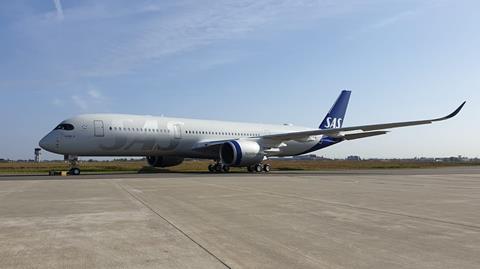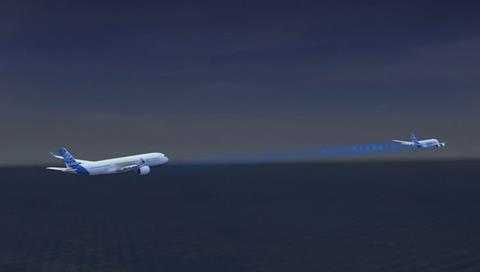Airbus has revealed that it has signed up A350 operators SAS and French Bee, alongside three European air navigation service providers (ANSPs), to help advance its fello’fly vortex-harnessing fuel-saving initiative.
The move comes on the back of a series of test flights conducted earlier this summer which proved it had been able to successfully automate the system.

Unveiled at the Dubai air show in 2019, fello’fly is designed to deliver fuel savings – and emissions cuts - of between 5-10% by enabling a trailing aircraft to benefit from the “smooth updraft” of air created by the wake of another large jet flying around 1.6nm (3km) in front.
Airbus says it has taken inspiration from the energy-saving formations flown by migratory birds to develop the concept, which it previously tested in 2016 using a pair of A380s.
However, Nick Macdonald, head of the fello’fly demonstrator programme, points out that those jets were hand flown to maintain the required separation.
But that process has since been automated, with the autopilot now able to maintain the correct distance between the two aircraft to “capture and track the vortex”. Airbus successfully demonstrated the revised system during a series of three flights performed in French airspace in the final week of July using a pair of test A350s – a -900 as the lead aircraft, followed by a -1000.
“The performance measurements were in line with our predictions,” says Macdonald. “It’s a good endorsement for the project.”
Macdonald declines to elaborate on the technology involved, and notes that the “final solution is something we are still working on”. However, he stresses that the eventual product will need to be as light as possible.
Airbus hopes it can certificate fello’fly – for both line- and retrofit – by 2025, but says this can only happen if the entire industry gets behind it, in part to develop the new regulatory framework required.
Working with its partners, Airbus will now attempt to sketch out a concept of operations for the new technology.
SAS and French Bee will “bring their knowledge of day-to-day operations” to the programme, says Macdonald, enabling insights on topics such as flight planning and crew workload.
Additional input from the ANSPs – DNSA in France, NATS in the UK, plus Eurocontrol - will help understand how aircraft could be paired, he says, and how procedures might need to change.

“There are lots of questions there which we will be working with the ANSPs and airlines to answer.”
Airbus intends to perform another round of internal test flights next year to ensure the maturity of its technology before it conducts a “final demonstration” over oceanic airspace with its partners “to prove all the bricks of the system fit together perfectly”.
“It is something that we really want to bring into service but we need support and collaboration across the industry,” says Macdonald.
Lars Andersen, head of sustainability at SAS, says that the airline has been involved in the project since late last year, although notes that its participation has been limited by the coronavirus crisis.
SAS will provide an A350 to act as a lead aircraft for the demonstration flight, to be conducted over the Atlantic, with one of the airframer’s A350 test fleet in the trail.
Andersen says the carrier will provide “some of the expertise from our experience every day when we fly our routes”.
Transoceanic flights are required for the demonstration effort due to the well-defined corridors and lengthy periods of stable flight.
While he points out that considerable regulatory changes are still required, SAS could be prepared to adopt fello’fly in the future.
“This is one step in a longer journey, but if the efficiency gains are worth the investment in the technology, possibly we will see this kind of methodology used on longer flights in future,” he says.























